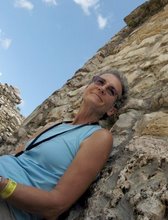
As I have written before, the majority of the ancient building material at Lakamha’ is limestone, since that was the material available to the people. Here is a Map of Don Juan Mountain that I created from a digital elevation model sent to me by Karen Bassie-Sweet. Palenque sits at the base of Don Juan Mountain whose makeup is limestone, as are the mountains of the Chiapas highlands, south of Don Juan.

This picture displays the hieroglyphic stairs of Court E of the palace. They are slowly dissolving, especially those facing upward. There are also glyphs on these stairs that you can see only from the front view. All rainwater is slightly acidic. When it falls on limestone as carbonic acid (solution mixture of the air and water) it slowly dissolves the rock. This process eventually forms cracks in the limestone rocks that become underground caves and water systems.

Cenotes are part of this system. Thanks to Flickr for this picture of a cenote at Ik Kil. Within the caves (defined as places that are large enough for humans to pass), stalactites and stalagmites are formed from this solution mixture. These formations are dripstone, a type of travertine. For more about types of limestone see: http://hyperphysics.phy-astr.gsu.edu/Hbase/geophys/limestone.html

So this means that when it rains on the buildings, they also begin to dissolve - like what is happening outside and inside the Palace. Here is a picture of a dripstone or a stalagmite that has formed inside one of the "T" windows. Perhaps these limestone buildings are even more vulnerable when they are reconstructed by archaeologists from unrecognizable dirt mounds into buildings.

In addition, the structures are also affected by rain runoff that flows around the buildings such as what happens in the Murcielagos group, but the ancient people who managed this group of buildings came up with an interesting way to deal with that water. They created a series of drains and pools to slow it down, perhaps.

We have plenty of buildings in the US made of limestone. For instance, most of the original courthouses of Texas are made of limestone. So why haven’t they also dissolved? It’s because these are only a couple of hundred years old. After 1,300 years, they too will experience dissolution, just like those at Palenque.

Presently, a method to protect the buildings has not been developed yet. The best that can be done is to build structures on top in order to shield from rain.
 I recently received a new National Geographic magazine collector's item publication in the mail.
I recently received a new National Geographic magazine collector's item publication in the mail. As I was flipping through the softbound book, I noticed the messages contained on the inside of the front cover.
As I was flipping through the softbound book, I noticed the messages contained on the inside of the front cover. And then I noticed the inside of the back cover. Delfino Lopez Hidalgo, one of the administrators at the Palenque site from the INAH (the Instituto Nacional de Antropología e Historia) told me that the governor of Chiapas, as well a the National Secretary of Tourism had spent large amounts of money in tourism advertising in order to promote the state of Chiapas. Visit http://www.sectorturismo.gob.mx/wb/sectur/sect_buscador?q=chiapas
And then I noticed the inside of the back cover. Delfino Lopez Hidalgo, one of the administrators at the Palenque site from the INAH (the Instituto Nacional de Antropología e Historia) told me that the governor of Chiapas, as well a the National Secretary of Tourism had spent large amounts of money in tourism advertising in order to promote the state of Chiapas. Visit http://www.sectorturismo.gob.mx/wb/sectur/sect_buscador?q=chiapas































 I am here to hone my GIS skills, to present information about my Don Juan project (the mountain right behind Palenque), to learn from other people doing archaeology GIS, and to learn the new GIS tools that ESRI has been developing for their products this year.
I am here to hone my GIS skills, to present information about my Don Juan project (the mountain right behind Palenque), to learn from other people doing archaeology GIS, and to learn the new GIS tools that ESRI has been developing for their products this year.











